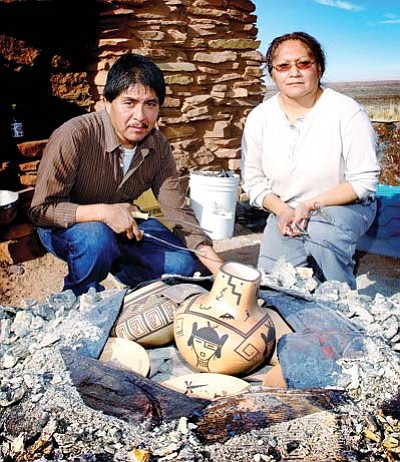Setalla siblings demonstrate Hopi pot firing at Homlovi
Creating ceramics in wintertime is very challenging
HOMLOVI STATE PARK, Ariz. - Gwen and Dee Setalla, brother and sister, provided an interesting demonstration of traditional Hopi pottery firing on Jan. 3. They started at around 11 a.m. and finished up around 2 p.m., demonstrating just north of the park's visitor center.
Traditional Hopi Pots are created, painted and fired from all natural occurring elements. The clay is dug from the Keams Canyon area. Black paint is produced from boiling mustard green liquid into syrup. The dried syrup mixed with a small amount of water using a hematite stone will create the permanent black paint applied to the pot before firing.
The material to fire the pot is dried sheep dung about two inches thick. The fire curing the pots will reach as high as 2,300 degrees using sheep dung fuel.
Firing as they did during winter, requires special preparation to isolate the fire and pots from the damp ground. This will affect the evenness of fire temperature and the resulting color of the pots. Wintertime cool air also is a cracking hazard to a newly fired pot, so the fire needs to cool off more before uncovering the pots in the winter. Summer firing is a little more straight forward with less restrictions.
Firing in traditional Hopi methods adds to the character of the pots and plates by providing "blush marks" or "fire clouds." These are darker areas on the ceramics, which occur because traditional firing outside with sheep dung has some unevenness of temperature and hotter areas. Shards of old fired pots are used in firing new pots. They are placed underneath, around the outside and on top of the ceramics to be fired.
Overall the "green" ceramics and shards is piled dried sheep dung, which is set on fire and provides an ideal temperature to turn the clay into stone.
For information on authentic Hopi ceramics for sale or demonstrations of traditional Hopi ceramic methods, call Gwen Setalla at (928) 797-7128.
SUBMIT FEEDBACK
Click Below to:




